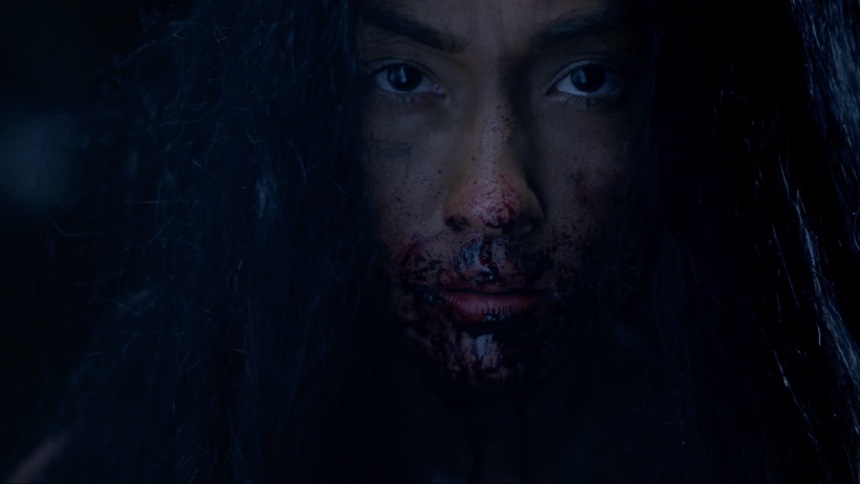Fantasia 2019 Review: MYSTERY OF THE NIGHT, A Woman's Scorn Awakens A Dark Spirit In The Phillipine Forest

Played out against a backdrop of political strife and religious domination, director Adolfo Alix, Jr.'s Mystery of the Night is a gripping tale of love and loss in the early 20th century Spanish-occupied Phillippines. An island nation under the thumb of a vast empire, the Philippines was one of many such East Asian countries at the time, and each of them had to grapple with the many changes these occupying forces brought. For some residents, the "civilizing" forces were welcome, bringing updated technologies, advanced science, and a general sense of connectedness with the outside world. However, the truth was much more complicated as rural and indigenous peoples and traditions were vilified as heretical in an increasingly oppressive religious society.
Mystery of the Night opens with the banishment of a raped woman into the forest where she is left for dead. The victim of a libidinous clergyman, the "crazy woman", as she's referred to for the majority of the film, gives birth to a baby girl who is soon adopted by the spirits of the forest and raised as their own.
When a solider from the nearby village makes his way into the forest for a bit of late night self-gratification, the girl, now a young woman herself, notices him and the two begin a passionate sexual affair. She cannot speak, as it was never necessary in all her years alone in the woods, but she and the man form a bond that transcends their sexual relationship anyway, until she finds out that they cannot be together, at which point she decides it's time to take revenge for all the wrong that has been done to her.
Already an established talent in the Philippines, Mystery of the Night marks Adolfo Alix's first foray into horror, and an impressive genre debut it is. Based upon the stage play Ang Unang Aswang (The First Aswang) by Rody Vera, the film explores the folk creature and its connection to the trauma experienced by the Filipino people during Spanish occupation. Traditionally shape-shifters with no real motives apart from doing harm to others, Mystery of the Night reimagines the Aswang as the result of a specific kind of trauma inflicted by a violent and patriarchal system meant to dole out revenge upon those who would wound the most innocent among them.
The film follows a fairly traditional three-act structure, with the first act introducing the scenario and setting and leading the audience into the forest where the eventual aswang's mother is abandoned. However, it is in the second act that things really start picking up steam. Here we are introduced to the daughter - dubbed Maria by her suitor - played boldly by model and actress, Solenn Heussaff, who performs her part like a ballet. Without words she is forced to act out her feelings through movement, a tough task that she takes on like a champ. Not only is she without language, her emotional and physical vulnerability is also expressed by the fact that she performs the part completely nude, without the concept of shame or fear, and she does so while delivering a performance in which none of these factors impede her form communicating exactly what the audience needs to know.
The film concludes with a third act full of longing, rejecting, catharsis, and revenge, and this is where the film really comes alive. Up until this point, Mystery of the Night is more or less a dramatic, more sensual retelling of The Jungle Book, with Maria replacing Mowgli, however, when it becomes apparent that the bond she thought she shared with her beau, Domingo (Benjamin Alves) is not unique, Mystery of the Night turns on the jets, and the blood begins to flow.
The balletic nature of Heussaff's performance through the second act takes on another level of expressiveness when she's asked to carry the violent final third of the film. This is where the film starts to show its seams a bit. With less than cutting edge effects to work with, the final horrific section of the film might make some serious gorehounds cringe a bit, but thankfully, Heussaff treats these obstacles as jumping off points for her final and most expressive bit of acting in the film. She takes advantage of the stage given to her to deliver a hauntingly violent and gory conclusion to a tragic story.
Mystery of the Night contains echoes of other well known stories that film fans will certainly recognize. The above reference to The Jungle Book is perhaps the most obvious, but the folk horror and more spiritual elements will have film fans recalling elements of Miyazaki's Princess Mononoke as well. Hell, there's even a bit of Zulawski's Possession in there if you stretch your mind a little bit, and even though the effects in the film might seem a bit rudimentary to western eyes, it all comes together nicely to tell a compelling story that's well worth checking out.
One of the reasons Screen Anarchy exists, right back to our earliest days, is to help spread the word about strange little films from the least understood corners of the world. With that in mind, it's very easy to recommend Mystery of the Night as an example of something exciting happening on the other side of the world that deserves attention. Adolfo Alix takes a look into a complex issue and ties it to local traditions in way that is uniquely Filipino, and that is fascinating to watch.







